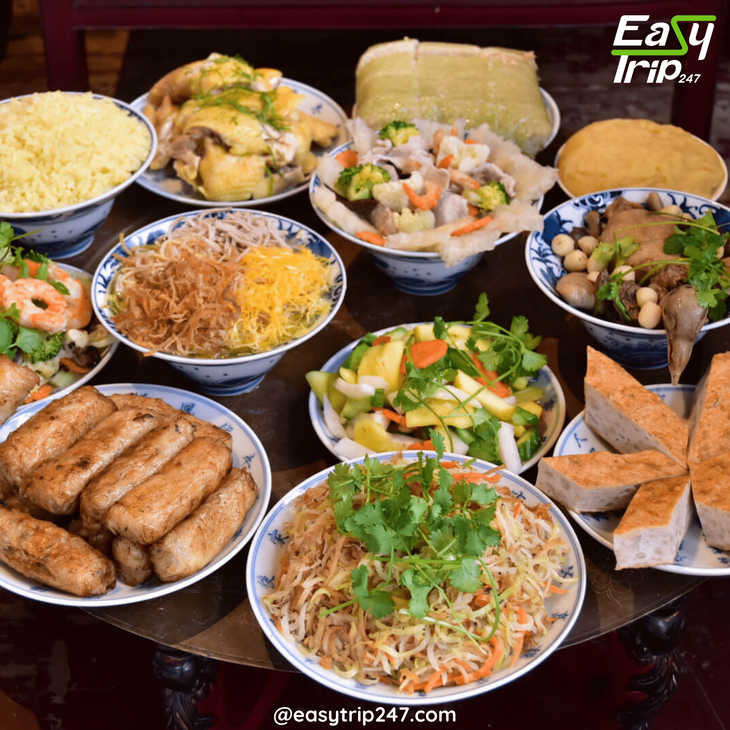When to Visit Vietnam for Food Enthusiasts: A Culinary Journey Through Bat Trang Pottery Village
On
23/06/2025Reading time:
1 min
Summary:
If you're a food lover planning your next trip to Southeast Asia, Vietnam should already be at the top of your list. But knowing the best time to visit Vietnam can take your culinary adventure from delightful to unforgettable—especially when your journey leads you off the beaten path to places like Bat Trang Pottery Village.

When it comes to experiencing Vietnam’s food scene, major cities like Hanoi, Saigon, and Hue often steal the spotlight. However, the best time to visit Vietnam for true culinary discovery might just be the moment you decide to explore its villages. Bat Trang is a place where the pace is slower, the ingredients are fresher, and the meals are often prepared with methods passed down through generations. From steaming pots of bánh đúc (rice flour cakes) → bánh đúc không phải món ăn ở Bát Tràng → Thay bằng “Squid and bamboo shoot soup” to freshly brewed herbal teas served in handmade ceramic cups, food in Bat Trang is not just nourishment—it’s heritage.
The best time to visit Vietnam for food lovers is typically during the spring (March to April) and autumn (October to early December). These seasons bring pleasant weather, mild humidity, and the kind of temperatures that make exploring local food markets, street-side eateries, and village homes an enjoyable experience. In Bat Trang, this means outdoor clay ovens fired up for crispy rice crackers, courtyard kitchens bustling with activity, and plenty of opportunities to join cooking demonstrations or share a meal with locals. The balance of cool breezes and sunny skies creates an atmosphere perfect for culinary curiosity.
Spring, in particular, offers a vibrant scene as villages prepare for festivals and ancestral celebrations. The air is filled with the aroma of traditional dishes like bánh chưng (sticky rice cake), bánh gai (sweet black rice cake), and xôi gấc (red sticky rice). Visiting Bat Trang during this season, you’ll not only savor these festive treats but see them being made in real family kitchens, wrapped in banana leaves, and steamed in giant pots—often over wood fires using handcrafted ceramic stoves. This intimate access is one reason many seasoned travelers believe it’s the best time to visit Vietnam.
Food in Bat Trang is also closely tied to the local ceramics industry. Many of the dishes you’ll try here are served in bowls, plates, or cups made just steps away in nearby workshops. The connection between what you eat and what it’s served in adds a unique dimension to the dining experience. You might be enjoying a hot bowl of bún thang → Thay bằng “fish soup” while sitting in a ceramicist’s courtyard, surrounded by rows of freshly glazed pottery drying in the sun. The blend of flavor and artistry is a defining aspect of visiting Bat Trang during the best time to visit Vietnam.
Autumn is another beautiful season to visit, especially for food enthusiasts who appreciate seasonal ingredients and cozy food settings. This is when the rice harvest comes in, when farmers bring fresh produce to local markets, and when the weather invites long, relaxing meals. In Bat Trang, food stalls begin offering warm bowls of cháo sườn (pork rib porridge), grilled corn with chili salt, and sweet treats like bánh trôi (glutinous rice balls with molasses). Enjoying these simple yet deeply comforting dishes while the leaves turn golden around you is a sensory experience that defines the best time to visit Vietnam.
One of the best-kept secrets of Bat Trang is the growing number of home-cooking classes hosted by local families. Unlike the commercial classes in Hanoi, these workshops are intimate, personal, and deeply rooted in tradition. You’ll learn to grind rice flour by hand, wrap dumplings using herbs grown in the family garden, and fry spring rolls over open clay stoves—all while sipping tea in hand-glazed cups. These experiences are usually offered during the more comfortable seasons of spring and fall, which further supports the idea that these are the best times to visit Vietnam for food-focused travelers.
Even beverages in Bat Trang tell a story. The village is known for its herbal drinks like nước vối (tea brewed from leaves of the vối tree) and chè xanh (fresh green tea), often served in beautiful, handmade teapots. When the weather is cool, sipping hot tea while chatting with locals in a pottery shop becomes more than a break—it becomes a moment of connection. These small, quiet experiences are often overlooked but become incredibly meaningful when you visit at the right time. It’s yet another reason why identifying the best time to visit Vietnam can shape your entire experience.
Food festivals and market days are also more frequent during the spring and autumn months. In Bat Trang, the village market turns into a lively showcase of local cuisine during these times. You’ll find displays of fermented vegetables, baskets of seasonal fruits, homemade tofu, and sticky rice in every imaginable hue. Vendors often offer free samples, and because the village doesn’t attract as many tourists as major hubs, they’re more open to sharing recipes, explaining ingredients, and even inviting you home for a meal. This level of warmth and openness is at its peak during the best time to visit Vietnam, when both locals and travelers are at ease.
In contrast, summer in Northern Vietnam can be hot, humid, and often interrupted by sudden rainstorms, which makes outdoor food adventures a bit challenging. Similarly, winter, while quieter, can be cold and overcast, limiting the vibrant market scenes and festive atmosphere that make Bat Trang so appealing. That’s why food lovers planning their trip around flavor, community, and discovery consistently choose spring and fall as the best time to visit Vietnam—and for good reason.
For those who love to document their travels, the lighting during these seasons is ideal. Photographers and food bloggers will appreciate the soft, natural light that enhances every steaming bowl and handmade plate. Whether you're snapping shots of sticky rice topped with mung beans or capturing the moment your hands shape a bánh ít (sticky rice dumpling), you’ll find endless inspiration during the best time to visit Vietnam.
In conclusion, Bat Trang Pottery Village offers far more than ceramics—it’s a treasure trove of culinary experiences, deeply rooted in Vietnamese culture and community. If you're a food enthusiast looking to explore authentic flavors in a setting that’s both charming and culturally rich, timing your trip is everything. The best time to visit Vietnam isn’t just about avoiding the rain or beating the heat; it’s about aligning your journey with the heartbeat of its people and their tables. And in Bat Trang, every dish tells a story, every cup holds tradition, and every meal shared is a memory made.
So, pack your appetite and your curiosity. Bat Trang is ready to welcome you—with open arms, warm bowls, and stories baked into every bite. Just make sure you choose the best time to visit Vietnam, and the experience will stay with you forever.
Design Your Tour Today And Get A Quote. Contact Us Here: +84.975.504.825
Source: Easytrip247 Team compiled.
